Biblical dwelling places unfold spiritual journeys, inviting exploration into divine relationships and ancient mysteries that shape faith.

Dwelling Place in the Bible
As you embark on this journey through the biblical landscape of dwelling places, think of yourself as a traveler exploring ancient ruins, each with its own story whispering secrets of the past.
From the lush Garden of Eden to the mobile Tabernacle in the desert, these places are more than just backdrops; they're characters in their own right, shaping the narrative of humanity's relationship with the divine.
As we explore these sacred spaces, you'll find that the concept of a 'dwelling place' evolves, reflecting shifts in understanding and relationship with God.
The path ahead is rich with insight, inviting you to uncover how these physical spaces mirror spiritual truths and what they might reveal about your own spiritual journey.
Key Takeaways
- Biblical dwellings symbolize humanity's journey from sin and exile to redemption and divine presence.
- Structures like the Tabernacle and Solomon's Temple highlight the importance of sacred spaces in connecting with God.
- The concept of dwelling evolves from physical locations to spiritual communion, as seen in Jesus' teachings and the promise of the New Jerusalem.
- Dwelling places in the Bible reflect themes of faith, obedience, and God's enduring promise of salvation and eternal home for believers.
The Garden of Eden

The Garden of Eden, often depicted as humanity's first home, represents a pivotal concept of paradise in biblical narratives, serving both as a literal and metaphorical foundation for the exploration of human origins and divine-human relationships. This idyllic setting is where you're introduced to the genesis of human existence, enveloped in perfection and direct communion with the divine. It's in this garden where the concept of original sin emerges, marking a significant turning point in the human-divine saga.
Original sin, as you'll find, isn't just a theological assertion but a profound narrative device that sets the stage for humanity's enduring struggle with morality, freedom, and the consequences of choice. The story of Adam and Eve's disobedience, prompted by the serpent's temptation, encapsulates the moment paradise was lost, thrusting humanity into a world marred by sin and separation from God. This narrative arc serves as a critical juncture, illustrating the transition from divine intimacy to existential exile.
Paradise lost, therefore, isn't merely an event but a thematic exploration of loss, accountability, and the pursuit of redemption. It underscores the fragility of perfection and the inevitability of human fallibility. As you delve deeper into this narrative, you're compelled to reflect on the underlying implications of these themes for understanding the human condition and the complex relationship between humanity and the divine.
In analyzing the Garden of Eden, you're not just uncovering the roots of biblical storytelling but engaging with questions about the essence of human nature and the eternal quest for reconciliation with the divine. The garden, with its profound symbolism, remains a cornerstone for interpreting the human experience within a theological context.
Noah's Ark
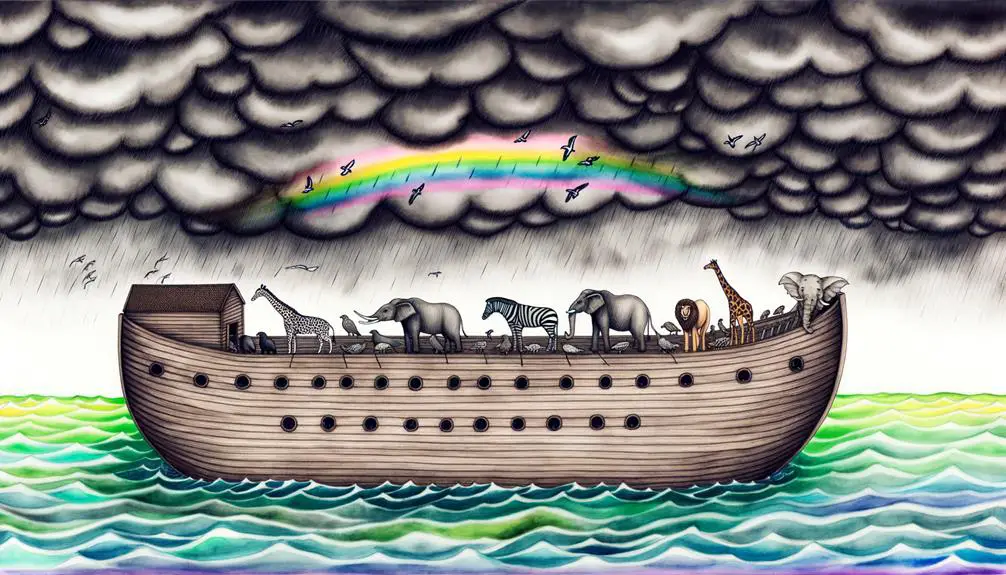
As you examine Noah's Ark, consider the intricate details surrounding its construction and dimensions, which underscore its significance as a divine architectural feat.
The process of animal boarding elucidates the logistical challenges and solutions inherent in preserving life.
Construction and Dimensions
Instructed by divine command, Noah embarked on constructing an ark with specific dimensions and materials, a task that underscores the intersection of faith and obedience in biblical narratives. The building materials and architectural influence of the ark reveal a profound understanding of ancient construction techniques, adapted for divine purposes.
- The chosen gopher wood symbolizes resilience and durability.
- Pitch coating inside and out ensures waterproofing, a testament to meticulous planning.
- The ark's dimensions, immense and precise, evoke awe and reflection on divine foresight.
- Its three-deck design demonstrates sophisticated spatial organization, hinting at an early understanding of ship architecture.
- Finally, the singular door symbolizes the sole path to salvation, inviting contemplation on the themes of choice and destiny.
This analytical exploration reveals the ark not just as a means of survival, but as a profound emblem of faith's journey.
Animal Boarding Process
How did Noah manage the monumental task of boarding animals onto the ark, a process that meticulously balanced divine command and logistical precision?
This endeavor, seemingly insurmountable, draws parallels with modern zoos and pet care, albeit on a far grander scale. In contemporary terms, such an operation would require a deep understanding of animal behavior, dietary needs, and spatial requirements.
Noah's approach to animal boarding likely involved strategic planning akin to modern zookeepers, ensuring each species' needs were met without compromise. The logistics of such an operation underline a blend of divine guidance and earthly pragmatism.
This narrative doesn't just highlight Noah's obedience but also showcases an early, albeit divine-inspired, application of principles seen in today's animal care and zoo management fields.
Survival and Aftermath
Having explored the logistical prowess required for Noah to board animals onto the ark, it's crucial to examine the survival strategies and the aftermath of this biblical event.
- The resilience displayed during the ark's journey mirrors the challenges faced during desert wanderings.
- Emerging from the ark, humanity's endurance was akin to the experience at Mount Sinai, marking a covenant renewal.
- The aftermath required adaptability, much like the Israelites' navigation through unfamiliar terrains.
- This event underscored the importance of faith and obedience under dire circumstances.
- Survival wasn't merely physical but also spiritual, laying foundations for future generations.
Analyzing these elements reveals the profound impact of Noah's Ark on biblical narratives, highlighting survival themes that resonate through subsequent stories, including those of desert wanderings and the pivotal moment at Mount Sinai.
The Tabernacle
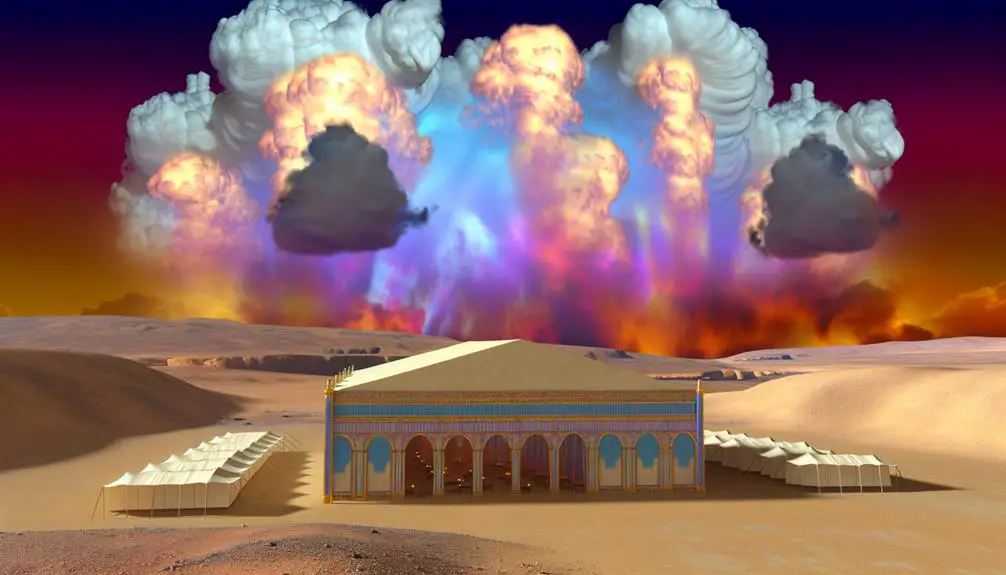
The Tabernacle, as described in the Bible, served as a mobile sanctuary for the Israelites, symbolizing God's presence among His people during their wilderness journey. This intricate structure not only facilitated worship and sacrifices but also embodied profound symbolism and theological significance, especially through its design and the priestly garments.
Delving into tabernacle symbolism, you'll find that every aspect was imbued with meaning. The Tabernacle's layout, comprising the outer court, Holy Place, and Most Holy Place, mirrored the concept of progressive sanctification. This physical arrangement underscored the idea of approaching God with reverence and purity. The materials used, from acacia wood to gold, and the colors of the fabrics, each held symbolic value, representing qualities such as divinity, purity, and atonement.
The priestly garments, as detailed in the biblical texts, were no less significant. These garments were designed with specific colors, materials, and ornaments, each symbolizing aspects of the priest's role as mediator between God and His people. For instance, the breastplate embedded with twelve stones represented the twelve tribes of Israel, underscoring the priest's role in bearing the people before God. The ephod, the breastplate, and the Urim and Thummim were instrumental in decision-making processes, signifying guidance and discernment.
In analyzing the Tabernacle, you're invited to appreciate not just its historical and cultural context but also its deep theological implications. It represents a divine dwelling place among humans, foreshadowing the ultimate reconciliation between God and His creation. Through this lens, the Tabernacle stands as a testament to God's proximity, holiness, and the pathway to His presence.
Solomon's Temple
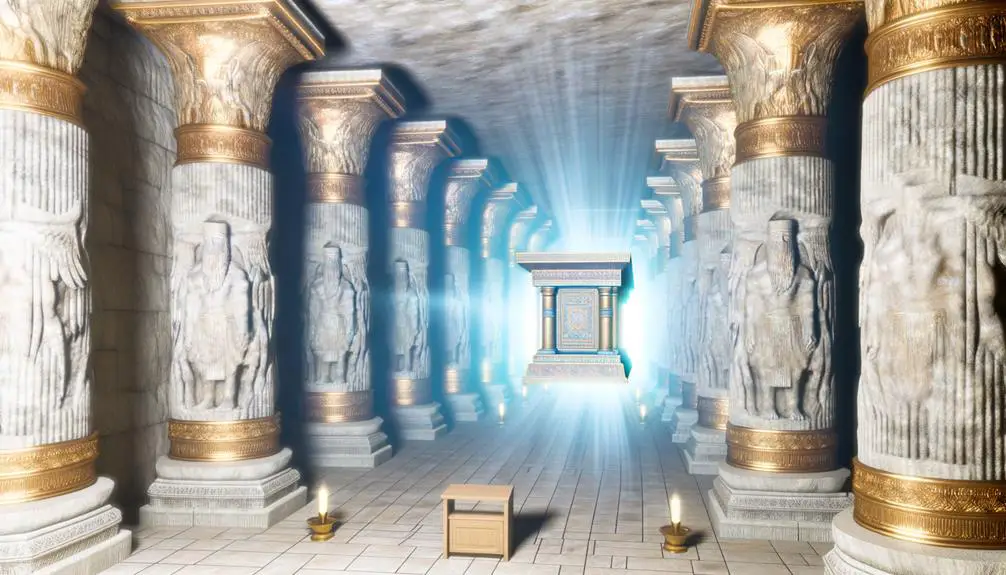
As you explore the construction and design of Solomon's Temple, you'll uncover the meticulous detail and planning that underlined its creation.
The sacred artifacts contained within its walls, from the Ark of the Covenant to the menorah, signify its central role in worship and religious practices.
Lastly, the temple's historical significance extends beyond its physical structure, reflecting its impact on Jewish identity and religious tradition.
Construction and Design
Solomon's Temple, a monumental achievement in ancient architecture, was meticulously designed to serve not only as a place of worship but also as a symbol of divine presence. The construction process involved careful material sourcing and integrated architectural symbolism to reflect its sacred purpose.
- Material sourcing was paramount, involving cedar from Lebanon and fine gold for the inner sanctuary.
- Architectural symbolism permeated every aspect, from the cherubim to the use of specific metals.
- The design aimed to evoke a deep sense of reverence and awe.
- Every detail, from the outer courts to the Holy of Holies, was imbued with meaning.
- The temple stood as a testament to the intersection of human craftsmanship and divine inspiration, inviting all who entered to ponder the mysteries of faith.
Sacred Artifacts Contained
Within Solomon's Temple, a collection of sacred artifacts held profound religious significance, each meticulously crafted to embody aspects of the divine. Among these, the Ark of the Covenant and the Holy Grail stand out, symbolizing the covenant between God and the Israelites and the cup of Christ, respectively. Analyzing these artifacts provides deep insights into the religious and cultural practices of the time.
Artifact |
Description |
Significance |
|---|---|---|
Ark of Covenant |
Gold-covered wooden chest with cherubim |
Symbol of God's covenant with Israel |
Holy Grail |
Cup used by Jesus at the Last Supper |
Represents Christ's sacrifice |
Menorah |
Seven-lamp ancient Hebrew lampstand |
Symbolizes the illumination of God |
Table of Showbread |
Gold table for showbread |
Represents divine provision |
Altar of Incense |
Altar for burning incense |
Symbolizes prayers rising to God |
This analysis reveals the profound spiritual meanings embedded within these artifacts.
Temple's Historical Significance
Exploring the historical significance of Solomon's Temple reveals its central role in ancient religious practices and societal structure. The temple's architecture and the religious ceremonies that took place within its walls were foundational to the cultural and spiritual identity of its people.
- *The grandeur of Solomon's Temple symbolized divine presence and favor.*
- *Its elaborate ceremonies fostered a deep communal bond and sense of belonging.*
- *The meticulous temple architecture reflected a cosmos in miniature, a heaven on earth.*
- *Sacrifices and rituals performed in the temple reinforced societal norms and moral values.*
- *The temple served as a physical and spiritual center, anchoring the community in their faith and traditions.*
Analyzing these aspects helps us appreciate the temple's profound impact on the development of religious thought and community cohesion.
Exile and Return

Amidst the tumult of history, the biblical narrative of exile and return profoundly illustrates the Israelites' enduring quest for a homeland. The period known as the Babylonian captivity emerges as a critical juncture, where despair and hope intermingle. You'll find that during this era, prophetic visions played a pivotal role in sustaining the spirit of the exiled community, promising them a return to their cherished land.
Event |
Impact on Israelites |
|---|---|
Babylonian Captivity |
Dislocation and spiritual crisis |
Prophetic Visions |
Renewed hope and faith in return |
Return to Jerusalem |
Reconstruction of identity and worship |
This table encapsulates the essence of the exile and return, highlighting the phases of despair, hope, and restoration. The Babylonian captivity wasn't merely a physical dislocation; it represented a profound spiritual upheaval. The prophets, however, weren't silent during this period. Their visions reassured the people of God's unfailing covenant, igniting a hope that transcended their immediate suffering.
The return to Jerusalem marks a pivotal moment in this narrative, signifying not just a physical return to a geographical location but a profound spiritual renewal. This period saw the rebuilding of the Temple, an act that was both literal and symbolic, representing the restoration of the covenant relationship between God and His people.
In analyzing this narrative, it's clear that the themes of exile and return are not just historical events but are imbued with deep theological significance. They speak to the resilience of faith amidst adversity and the unbreakable bond between a people and their divine promise of a dwelling place.
Jesus and Dwelling Places
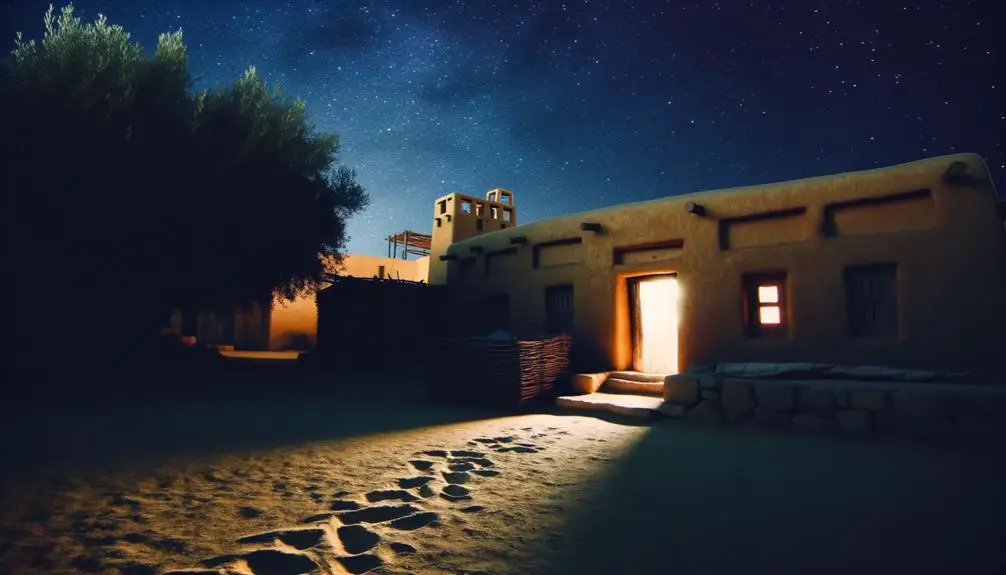
Building on the narrative of exile and return, we now turn our attention to how Jesus redefines the concept of dwelling places in the New Testament. Jesus' teachings, particularly through parable interpretations, challenge and expand the traditional understanding of where and how the divine presence dwells among humanity.
Jesus introduces the idea that the Kingdom of God isn't confined to a specific location but is present wherever there's faith, love, and obedience to God's will. This conceptual shift is profound, indicating that the sacred can be encountered in the everyday lives of those who follow Him. Through His words and actions, Jesus illustrates that dwelling with God isn't about a physical structure but about the quality of one's relationship with the divine.
Here are key points that evoke the emotional depth of Jesus' redefinition of dwelling places:
- Jesus' assertion that 'where two or three are gathered in my name, there am I among them' emphasizes community and mutual support as a dwelling place for the divine.
- The parable of the Good Samaritan, teaching that acts of kindness and compassion create spaces where God's presence is manifest.
- Jesus' invitation to the marginalized, showing that God's dwelling place is accessible to all, regardless of social status.
- The Last Supper, symbolizing the creation of a new covenant where Jesus dwells within believers through the Eucharist.
- Jesus' promise of the Holy Spirit, ensuring that God's presence remains with His followers, guiding and comforting them.
These elements collectively underscore the shift from a physical to a relational understanding of dwelling places, deeply rooted in love, action, and community.
The New Jerusalem

Transitioning to the concept of the New Jerusalem, we delve into a biblical vision that symbolizes the culmination of divine promise and human hope in a renewed creation. This heavenly city, as depicted in the scriptures, stands as a profound emblem of God's eternal kingdom, embodying perfection, peace, and the ultimate reconciliation between the divine and humanity. It's not merely a physical locality but a symbolic representation of the eschatological fulfillment of God's plan for salvation and restoration.
The imagery of the New Jerusalem is rich with Bride symbolism, intricately weaving the relationship between God and His people. This metaphor accentuates the intimate and covenantal bond, portraying the city not just as a dwelling place but as a cherished partner in divine communion. The Bride symbolism further highlights the transformative nature of the relationship, where the coming together of the heavenly city and its inhabitants signifies a new beginning, erasing the former things and ushering in an era of righteousness and joy.
Analyzing the descriptions of the New Jerusalem, one observes its foundational aspects rooted in purity, light, and divine presence. The absence of a temple in the city underscores the pervasive presence of God, where He Himself is the temple, and the lamb is its light. This architectural and metaphysical construct invites believers to envision their ultimate place in God's eternal narrative, where sorrow, pain, and death are no more.
In essence, the New Jerusalem encapsulates the hope for a future where God dwells among His people in a space that's holy, unmarred by sin, and reflective of His glory. It's a vision that calls believers to a higher anticipation of what lies ahead in the divine scheme of redemption and renewal.
Frequently Asked Questions
How Does the Concept of a Dwelling Place Evolve From Personal to Communal in the Biblical Narrative?
In the narrative, you see a shift from a nomadic lifestyle to a communal existence. This transition is marked by an architectural evolution, where personal shelters morph into shared spaces.
Initially, individual dwellings reflect a solitary relationship with the divine, but as the story unfolds, communal structures emerge, symbolizing a collective spiritual identity. This evolution from personal to communal dwelling places underscores a deepening understanding of community and its sacred significance.
In What Ways Do Dwelling Places in the Bible Reflect the Relationship Between Humans and the Divine?
As you delve into the study, remember that 'home is where the heart is,' especially when analyzing the interplay between humans and the divine.
The narrative reveals that dwelling places, guided by Divine Commands, symbolize the profound relationship humans share with the divine.
This connection deepens during the Human Exodus, illustrating a shift from mere physical structures to a communal bond with the divine, underscoring an evolving spiritual journey and devotion.
Are There Any Instances Where Natural Landscapes, Rather Than Constructed Spaces, Are Considered Sacred Dwelling Places in the Bible?
Absolutely, natural landscapes are indeed recognized as sacred spaces. For instance, mountain altars are pivotal venues where divine communications often happen. These high places serve not just as physical elevations but as spiritual meeting points between humanity and the divine.
Similarly, desert encounters are instrumental in depicting profound spiritual experiences, highlighting solitude's role in facilitating a deeper connection with the divine. These instances underscore nature's role as a conduit for divine encounters.
How Do the Materials Used in the Construction of Biblical Dwelling Places Symbolize Different Theological or Spiritual Meanings?
In analyzing material significance and architectural metaphors, you'll find that different materials used in construction carry deep theological or spiritual meanings.
For instance, gold often symbolizes purity and divinity, suggesting a heavenly connection.
Stone, on the other hand, may represent strength, permanence, or God's unchanging nature.
These choices aren't arbitrary; they're carefully selected to convey specific messages, enhancing the understanding of sacred spaces through a symbolic lens.
Can the Transition Between Temporary and Permanent Dwelling Places in the Bible Be Seen as a Metaphor for the Spiritual Journey of Faith?
You're exploring how transitions from temporary to permanent homes can mirror your spiritual migration and faith journey. This shift often symbolizes deepening commitment and understanding in one's spiritual walk.
As you delve deeper, consider how these physical movements reflect inner transformations and growth in faith. Analyzing this metaphor can reveal insights into the complexities of spiritual development and the stages of belief one navigates through their life.
Conclusion
In conclusion, from the verdant expanses of the Garden of Eden to the celestial streets of the New Jerusalem, the Bible presents a tapestry of divine dwelling places that's nothing short of cosmic.
You've journeyed through sacred spaces that have housed humanity in its infancy, its trials, and its ultimate redemption. Each locale, be it as humble as Noah's Ark or as grandiose as Solomon's Temple, serves as a testament to the enduring relationship between the divine and mankind.
This exploration reveals the Bible's profound narrative not just as a historical account, but as an eternal invitation into fellowship with the divine.

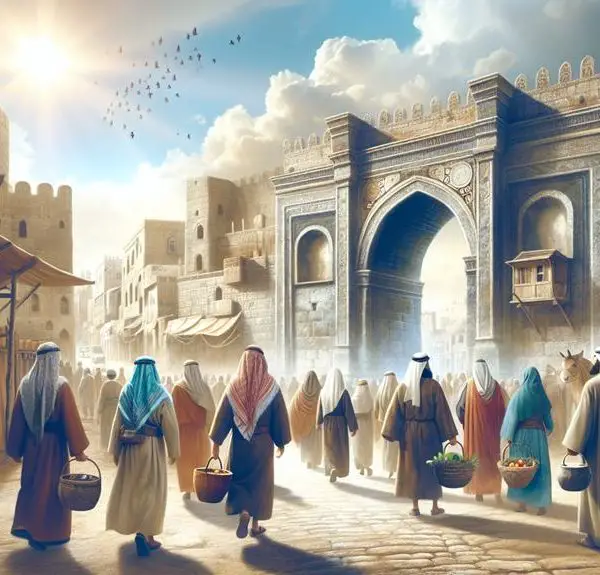
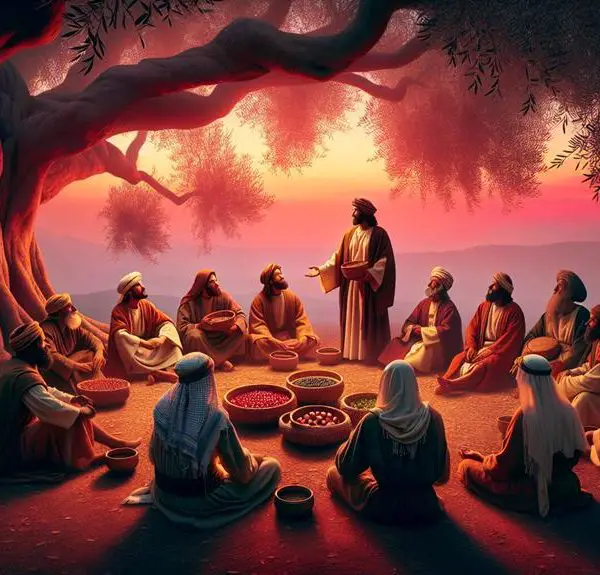
Sign up